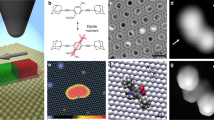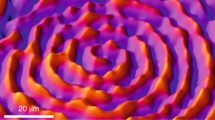Abstract
The adsorption of organic molecules on solid substrates is a fundamental step in many important heterogeneous catalytic processes, and is also becoming an increasingly significant aspect of surface modification in microelectronics and sensing technology. The conformation of adsorbed molecules not only influences the outcome of surface-catalysed reactions but also becomes important for recognition processes involved in chemical sensors. The scanning tunnelling microscope (STM) is uniquely able to monitor surface structures at the individual-molecule level1, and has been shown previously to be capable of distinguishing between different molecular conformations on a surface2. Here we show that the geometric configuration (cis or trans) of several simple alkenes chemisorbed on the silicon (100) surface can be determined using the STM, through its ability to identify individual methyl groups. Because both the position and the orientation of these groups can be seen, we can determine the absolute configuration (R or S) for each of the chiral centres formed on chemisorption. Thus the STM can probe enantioselective processes at surfaces at the single-molecule level, and may assist in the development of structured chiral surfaces capable of complex recognition tasks.
This is a preview of subscription content, access via your institution
Access options
Subscribe to this journal
Receive 51 print issues and online access
$199.00 per year
only $3.90 per issue
Buy this article
- Purchase on Springer Link
- Instant access to full article PDF
Prices may be subject to local taxes which are calculated during checkout


Similar content being viewed by others
References
Binnig, G., Rohrer, H., Gerber, Ch. & Weibel, E. Surface studies by scanning tunneling microscopy. Phys. Rev. Lett. 49, 57–60 (1982).
Jung, T. A., Schlitter, R. R. & Gimzewski, J. K. Conformational identification of individual adsorbed molecules with the STM. Nature 386, 696–398 (1997).
Becker, R. & Wolkow, R. A. in Scanning Tunneling Microscopy (eds Stroscio, J. A. & Kaiser, W. J.) Vol. 27in Methods of Experimental Physics (Academic, 1993).
Bozack, M. J., Taylor, P. A., Choyke, W. J. & Yates, J. T. J Chemical activity of the C=C double bond. Surf. Sci. 177, L933–L937 (1986).
Yoshinobu, J., Tsuda, H., Onchi, M. & Nishijima, M. The adsorbed states of ethylene on Si(100)c(4x2), Si(100)(2x1), and vicinal Si(100)9°: electron energy loss spectroscopy and low energy electron diffraction studies. J. Chem. Phys. 87, 7332–7340 (1987).
Clemen, L. et al. Adsorption and thermal behavior of ethylene on Si(100)-(2 × 1). Surf. Sci. 268, 205–216 (1992).
Huang, C., Widdra, W. & Weinberg, W. H. Adsorption of ethylene on the Si(100)-2x1 surface. Surf. Sci. 315, L953–L958 (1994).
Fisher, A. J., Blochl, P. E. & Briggs, G. A. D. Hydrocarbon adsorption on Si(100): when does the silicon dimer bond break? Surf. Sci. 374, 298–305 (1997).
Pan, W., Zhu, T. & Yang, W. First-principles study of the structure and electronic properties of ethylene adsorption on Si(100)-2x1 surface. J. Chem. Phys. 107, 3981–3985 (1997).
Kiskinova, M. & Yates, J. T. Observation of steric conformation effects in hydrocarbon adsorption and decomposition: cis- and trans-butene-2 on Si(100)-(2x1). Surf. Sci. 325, 1–10 (1995).
Dewar, M. J. S. & Thiel, W. Ground states of molecules. 38. The MNDO method. Approximations and parameters. J. Am. Chem. Soc. 99, 4899–4907 (1977).
Davis, L. P. et al. MNDO calculations for compounds containing aluminum and boron. J. Comput. Chem. 2, 433–438 (1981).
Dewar, M. J. S., McKee, M. L. & Rzepa, H. S. MNDO parameters for third period elements. J. Am. Chem. Soc. 100, 3607 (1978).
Dewar, M. J. S., Zoebisch, E. G. & Healy, E. F. AM1: a new general purpose quantum mechanical molecular model. J. Am. Chem. Soc. 107, 3902–3909 (1985).
Dewar, M. J. S. & Reynolds, C. H. An improved set of MNDO parameters for sulfur. J. Comput. Chem. 2, 140–148 (1986).
Wolkow, R. A. & Avouris, Ph. Atom-resolved surface chemistry using scanning tunneling microscopy. Phys. Rev. Lett. 60, 1049–1052 (1988).
Boland, J. J. Role of bond strain in the chemistry of H on Si(100). Surf. Sci. 261, 17–25 (1992).
Mayne, A. J. et al. An STM study of the chemisorption of C2H4on Si(001)(2x1). Surf. Sci. 284, 247–256 (1993).
Liu, H. & Hamers, R. J. Stereoselectivity in molecule surface reactions: adsorption of ethylene on the Si(100) surface. J. Am. Chem. Soc. 119, 7593–7594 (1997).
Wolkow, R. A. Direct observation of an increase in buckled dimers on Si(001) at low temperature. Phys. Rev. Lett. 68, 2636–2639 (1992).
Author information
Authors and Affiliations
Corresponding author
Rights and permissions
About this article
Cite this article
Lopinski, G., Moffatt, D., Wayner, D. et al. Determination of the absolute chirality of individual adsorbed molecules using the scanning tunnelling microscope. Nature 392, 909–911 (1998). https://doi.org/10.1038/31913
Received:
Accepted:
Issue Date:
DOI: https://doi.org/10.1038/31913
This article is cited by
-
Breakdown of chiral recognition of amino acids in reduced dimensions
Scientific Reports (2020)
-
Redox-Active Ferrocene grafted on H-Terminated Si(111): Electrochemical Characterization of the Charge Transport Mechanism and Dynamics
Scientific Reports (2019)
-
Assigning the absolute configuration of single aliphatic molecules by visual inspection
Nature Communications (2018)
-
Stereoselectivity and electrostatics in charge-transfer Mn- and Cs-TCNQ4 networks on Ag(100)
Nature Communications (2012)
-
Directed long-range molecular migration energized by surface reaction
Nature Chemistry (2011)
Comments
By submitting a comment you agree to abide by our Terms and Community Guidelines. If you find something abusive or that does not comply with our terms or guidelines please flag it as inappropriate.



